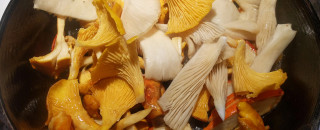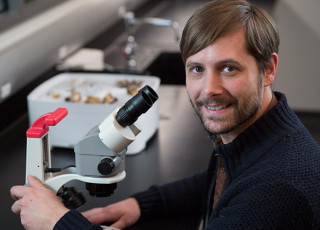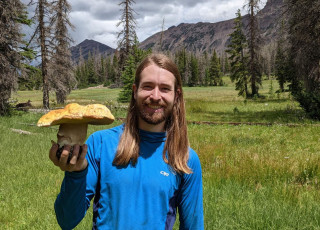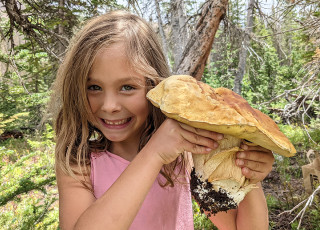Fermented Foods & Fungal Delights
This article was produced in advance of Bryn Dentinger's presentation at the Utah Food Festival, happening May 4 and 5 at NHMU. Join us at the festival for food presentations from NHMU scientists, culinary workshops taught by local experts, and a market featuring some of Utah's best sweet and savory flavors.
By Jude Coleman
While the mushrooms on your pizza are a modern flavor combination, humans have been eating mushrooms and other Fungi for thousands of years. Scientists have found medicinal mushrooms in the stomach of a 5,300-year-old European mummy, for example. Other researchers have uncovered mushroom spores on the teeth of a human skeleton from nearly 20,000 years ago.
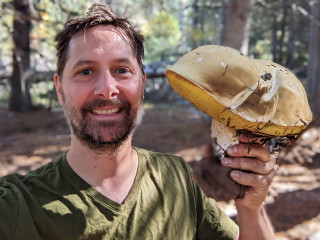
Dr. Bryn Dentinger holding a large porcini mushroom. Photo by Bryn Dentinger
The mushrooms these ancient people ate, and the ones we eat today, are the spore-bearing structures of Fungi. It’s what they use for sexual reproduction. The rest of the organism lives underground, its cells strung together in a thread-like arrangement called mycelium. But although all mushrooms are Fungi, not all Fungi are mushrooms. Only a small fraction of the tens of thousands of fungus species on Earth produce a mushroom. Other non-mushroom Fungi include organisms like yeasts and molds. These Fungi can also be edible — without them, we wouldn’t have certain alcoholic beverages or cheeses, said mycologist Bryn Dentinger. Dentinger is the Curator of Mycology at the Natural History Museum of Utah and an Associate Professor in the School of Biological Sciences at the University of Utah. He got his start as a mushroom enthusiast as a teenager, searching for them in the forest or garden and trying to decipher their identity.
“It’s just fascinating. It's like an Easter egg hunt,” he said.
Dentinger will share a snapshot of his passion for Fungi at NHMU’s Utah Food Festival in a presentation titled, “Fermented Foods and Fungal Delights.” The presentation takes place on May, 5, at 2 p.m in the Community Room.
Fungi can wear several hats in nature, but one of their important roles is as decomposers. Without them, dead organisms would pile up, their nutrients still locked inside. While breaking down organic matter, Fungi sometimes create something tasty in the process, either as a mushroom or as a byproduct.
Take beer, for example. The bubbly brew is a result of fermentation, a process where yeast eats sugar and breaks it down into alcohol and carbon dioxide. Because clean water was more difficult to come by hundreds of years ago, people drank more beer than water — the fermentation process prevented harmful microbes from growing in the drink. Bakers also harness yeast’s power, using the fungus’ gassy production to leaven bread. Between bread and beer, Dentinger said, Fungi were likely foundational to humans’ shift from hunter-gatherer lifestyles to more agrarian ones.
“The more you know about Fungi and what they do in the world, the more you just get drawn into them,” he said. “If they weren't around, we wouldn't be around.”
Anytime you consume soy sauce, miso or sake, you can also thank Fungi. They’re created through a fermentation process similar to yeast, except a mold is the Fungus responsible for fermentation. The thought of eating mold might seem counterintuitive; after all, the green fuzz sprouting atop a forgotten hamburger bun is mold, and no one wants to eat that. The difference is that bread mold can cause illness, while beneficial molds, similar to yeasts, help prevent harmful organisms and toxins from forming in food. With both yeast and mold, what stands between icky, rotten food and flavorful fermented food is competition between the decomposing organisms. “If you don’t experience fermented foods, you haven’t experienced what the world has to offer,” Dentinger said.
The right mold in the right place produces another fungal delicacy: cheese. Several varieties of cheese, such as bleu or gorgonzola, are defined by mold that is specifically responsible for the funky flavor it imbues. The molds used in these types of cheese are in the Penicillium genus. If that sounds familiar, it’s because Penicillium is the same genus that produces the world’s first antibiotic medicine, penicillin.
Fungi that contribute flavor or fermentation in this way don’t produce mushrooms. In fact, mushrooms are in a completely different part of the Fungi kingdom. When people picture eating a mushroom, they’re most likely thinking of the button mushroom, Dentinger points out, the little white ones typically found plastic-wrapped in the produce aisle. However, there are many other edible varieties found outside the store, and wild mushrooms usually have a more diverse and subtle flavor profile. Flavors range from nutty and earthy, like morel mushrooms, to floral and fruity, like chanterelles. One mushroom, the candy cap, smells and tastes like maple syrup and is used in desserts.
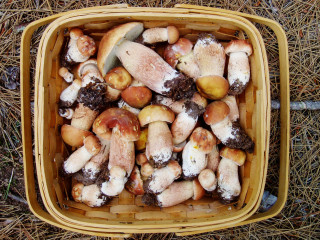
Wild porcini mushrooms in a basket. Photo by Bryn Dentinger
In Utah, several edible mushroom species abound in the wild. This time of year, the morel season is just starting. As spring turns to summer, the elevation at which foragers can find morels will move upward, so mushroom hunters can harvest them as late as July up in the mountains. At the end of summer, foragers can find oyster mushrooms, which are easy to identify and typically grow on dead cottonwood and aspen trees. And from roughly July to October, Utah’s state mushroom is out in abundance: the porcini. In Utah, porcini grow exclusively near conifer trees. In Utah’s mountains, they can be found nestled in the duff beneath spruce, Douglas fir and fir trees.
When searching for mushrooms to take home, it’s important to consider their growing environment to help narrow the search. Some mushrooms have specific, limited habitats in which they’ll grow, similar to how porcini will only grow in conifer forests in Utah. Also, consider how moist an area is, and during dry times of the year, limit the search to wet areas. Those are usually places like seeps or streams in the mountains.
“Foraging on public lands requires either a permit or knowledge of what you're allowed to collect,” Dentinger said. “Make sure you know what the rules are.” In addition to legal rules, foraging etiquette is to leave the soil and surrounding habitat as undisturbed as possible.
After all the hard work of finding wild mushrooms is over, they will need to be cooked. Mushrooms are mostly water, so cooking them on medium-high heat is a good way to concentrate the flavor. At low temperatures, the mushrooms stream in the liquids they release, rendering them, well, mushy. Alternatively, high heat can leave them burnt. The goal is to evaporate water from the mushrooms while caramelizing, giving them a chewy bite. Properly cooking them can be the difference between enjoying their flavor or swearing them off for good. But even if someone isn’t a fan of the common varieties found at the store, Dentinger encourages everyone to expand their mushroom repertoire and try new kinds before giving up. “The flavors that you can find in wild mushrooms are way different,” he said. “People should give mushrooms a second chance if they think they don’t like them.”
